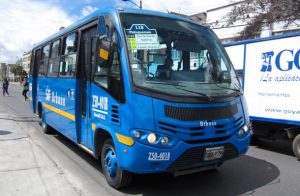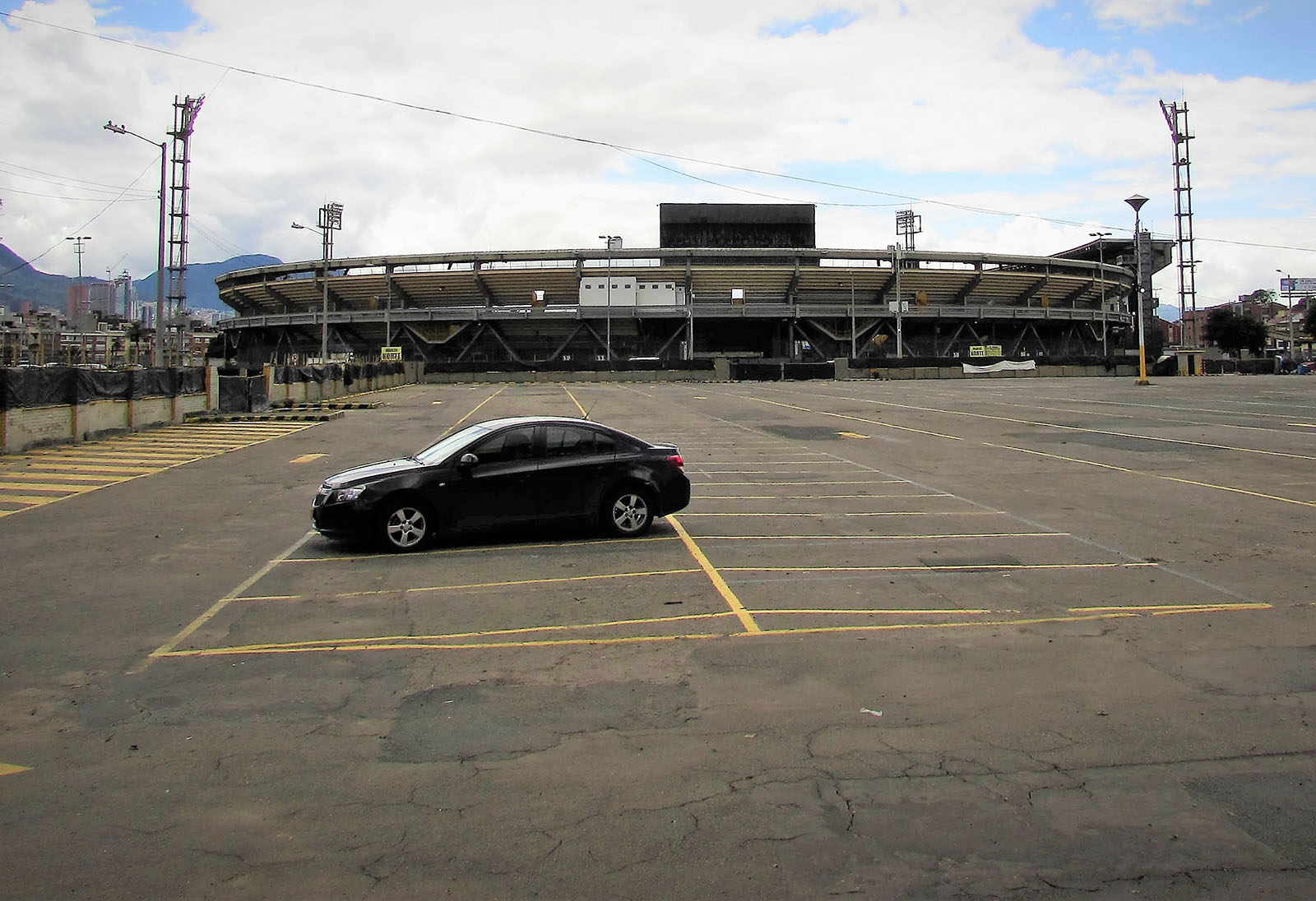
The Blue SITP busses will become a more common sight on the streets of the capital/
In theory, by the end of May, the SITP buses will rule Bogota’s roads – replacing or running all the existing busetas and colectivos. Diana Mejía, Kate Brunette and Chris Erb take a look at what the SITP has to offer, and whether the city is ready for the blue bus revolution
An introduction to the SITP…
When Transmilenio first took to the streets of Bogota in 2000, it radically changed the way millions of people moved around the city every day. Twelve years later, Bogotanos were introduced to the next significant phase of integrated public transit in the city, the catchily named Sistema Integrado de Transporte Público (SITP), which will reach the final stage of its implementation this year.
The system is intended to standardise the operation of private buses in the city, with the aim of developing a public transportation system that provides complete coverage of the city, integrating fares and operations and therefore bringing balance to transportation demands in all areas. Additionally, it will improve the current fleet of buses on the roads in order to reduce road accidents and provide better accessibility.
The SITP project was spearheaded by former mayor Samuel Moreno (now in prison for embezzling millions in city funds), but it was only under the mayorship of Gustavo Petro that the first SITP routes were launched. But the implementation has been plagued by delays, financial difficulties, drivers’ strikes, and a slow uptake by the public the system is supposed to serve, as many commuters still don’t how to get where they’re going on the blue buses.
This new system operates as a public-private partnership, where the owners of the former colectivo companies have become the service providers for the city’s integrated transportation plan. Under this scheme, routes, schedules, and payment options have been standardised and integrated across the city-wide system. It is expected that just 13 private companies will service the city with the easily recognisable SITP buses.
The new buses will address some of the issues that have plagued the existing private bus system. Colectivo drivers are paid on a system that rewards speed and encourages picking up as many passengers as possible. Because of the incentives associated, drivers often try to cram passengers into their buses while driving as fast as they can manage.
By contrast, SITP drivers are paid a salary regardless of the number of passengers they transport, so they’ll be less likely to cram their buses to dangerous extremes. The traditional bus system lacks safety regulations, and the rules that do exist are almost never enforced. While it is illegal to drive the bus with the doors open, busetas can be seen on a daily basis with people hanging out of the open doors.
Further, colectivo drivers often have to manage their own tills and give change while driving, which can distract the driver and lead to accidents. This problem has been addressed by SITP through the use of prepaid transit fare cards that register at an automated till, freeing the driver from having to dole out change. These cards offer another advantage over traditional buses to users: the ability to make transfers from bus to bus for free or at a discounted fare.
Lastly, the SITP buses should address some of the pollution problems associated with the antiquated private buses that spew black smoke into the streets. Buses from before 2004 are not allowed to form part of the SITP fleet, and those built after 2009 must have diesel particle filters installed in their exhaust.
What is the SITP and how is it different from the Transmilenio?The SITP includes the existing Transmilenio system as well as adding three new types of buses that you may have seen around town:
How do I use the new buses?The SITP has established stops, and you must pay for the bus using any one of your existing Transmilenio smartcards – Tu Llave, Cliente Frecuente or Monedero – instead of cash. To catch a SITP bus, find a bus stop and read the sign to see which buses stop there. When getting off the bus, you must also exit at a specific stop. Keep your eyes peeled and press the button to let the driver know that you will be getting off at the next stop. You have the option to transfer to another SITP option (buses or Transmilenio) within 75 minutes of the start of your journey at a discounted fare. There is no charge during off-peak hours, and it’s only $300 COP during peak hours. |
Growing pains
According to the city’s Secretaría de Movilidad, more than 5,500 independent busetas have been replaced with SITP vehicles. This number is expected to double in the next few weeks, when SITP will take over the current transportation system. This seemingly massive undertaking is happening under less than ideal conditions. In effect, the SITP will be taking control of operations of over 5,000 private buses that will operate as de-facto SITP buses. Although they will still take cash payments, they will have the same fare as SITP and will only stop at designated bus stops.
Considering the major difficulties already faced by the SITP, the logistical and bureaucratic challenges of this huge handover must prompt fears of more problems to come. From the very beginning, the SITP faced major financial and operational issues. The existing seven contractors for the system are all currently operating with losses and until recently, two other SITP contractors responsible for 30 percent of the routes in Bogota – Coobus and Egobus – had been unable to even start operations due to financial difficulties.
The final stage of the SITP transition is due to be completed in December, by which time, more than 5,000 buses will have a new operator, 8,000 more will have been taken off the road, and thousands of former buseta drivers will have been re-employed by the SITP system. All of this is expected to be implemented by an organisation beset by financial difficulty.
The good and bad of riding the SITPFor many people in the city, the SITP buses are a challenge to navigate. The way people have traditionally identified the routes and paid for their transportation, and the routes themselves, have radically changed over the past few years. Gone are the easily identified tablas that allowed commuters to recognise their route at the glance of a sign. They have been replaced by buses with inexplicable codes and routes printed on a linear map that may not be intuitive to read for current riders. The lack of education and information about the SITP buses has been one of the greatest shortcomings of the system and may explain the low ridership in the early phases of its implementation; when weekly revenue reached only half of what was projected in 2014.
“The SITP has improved several things: security, time, but mostly, Bogotano culture. It is safer than the old busetas because the drivers don’t carry cash and the users don’t need to either, and there aren’t so many people getting in the back door or asking everyone for money,” regular SITP user María Alejandra Ortega told The Bogota Post. “In terms of time, they are still forced to use Bogota’s busy roads, but the fact that they are not stopping every minute, like old busetas do, is very useful, especially if you are in a hurry,” she said. “Also, we were used to angry drivers competing to get as many people on as they could, but now they don’t. Lots of old people are frustrated because they have to walk to stops, but if you learn how to use it, it’s much better,” Ortega added. |
What we’ll miss about colectivos
In a few months, most of the remaining private buses will be taken off the roads of Bogota and replaced with the various colours of the SITP buses. While the buses of old are generally decrepit and overcrowded, frequently uncomfortable, arguably unsafe, and often poorly driven, there are a few little things we’ll miss about them:
Cash payments: What better way to empty that piggy bank full of 50, 100, 200, and 500 peso coins than on the bus? Not having to trudge over to a Transmilenio station and stand in a queue to fill up your card is a major plus for convenience.
Hailing a bus from anywhere: Anyone who has lived in a fully developed city knows that to get on a bus, you dutifully do so at a bus stop. However, there is something liberating about being able to hail a bus from wherever you happen to be standing. It’s also nice to be able to push the button and get off in the middle of an overpass if you’re stuck in traffic and it’s obvious that it’s going to be faster to walk than continue to stand around on the bus.
Personalised buses: The SITP buses may be clean and spacious but they lack the personalised touch of the private buses. Gone will be the oversized tassels on the windows and shifters, and where else can you see elaborate decals of the Virgin Mary and a machine gun-toting Rambo side-by-side?
Excitement: When you get on a private buseta, you never know what you’re going to get. Maybe it will be clean and well maintained, or perhaps it will be held together with duct tape. The drivers are often quite creative with lighting and decorations, and music on the bus often adds a lively and fun atmosphere.
How do I know which route to take?You can find information about the SITP on its website www.sitp.gov.co, Mi Ruta Facil www.mirutafacil.com, or you can download Moovit www.moovitapp.com, or TransmiSitp www.transmisitp.com app to your smartphone. Google Maps also includes SITP data when you search it for directions between two points in Bogota. |
By Diana Mejía, Kate Brunette and Chris Erb

 • Blue Urbano buses that run on main roads, connecting different zones of the city.
• Blue Urbano buses that run on main roads, connecting different zones of the city. To aggravate the problem, most of the mobility resources that allow users to plan their routes are geared towards tech-savvy people with smartphones or computers readily at their disposal, in a city where ridership falls heavily on the poor working class. Twenty percent of Colombians still don’t have any internet access, and less than half of all mobile phones are smartphones, so large numbers of potential passengers can’t access route planners. That being said, for those who do have access to such smartphone apps, the SITP gets very close to providing the kind of bus experience that developed countries with well-established transportation systems provide.
To aggravate the problem, most of the mobility resources that allow users to plan their routes are geared towards tech-savvy people with smartphones or computers readily at their disposal, in a city where ridership falls heavily on the poor working class. Twenty percent of Colombians still don’t have any internet access, and less than half of all mobile phones are smartphones, so large numbers of potential passengers can’t access route planners. That being said, for those who do have access to such smartphone apps, the SITP gets very close to providing the kind of bus experience that developed countries with well-established transportation systems provide.



